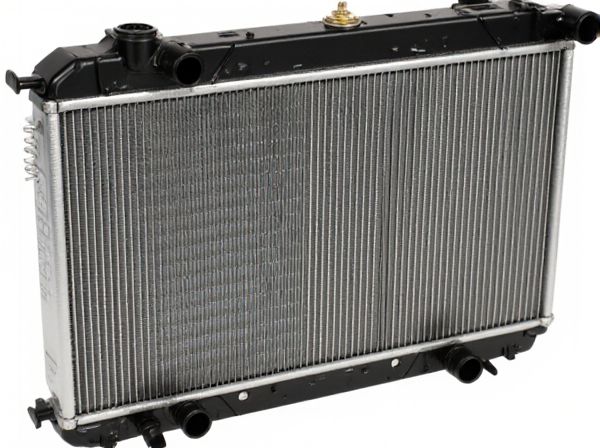
Photo illustration: OEM Style vs Performance Radiator
An OEM style radiator offers reliable, factory-grade cooling performance designed to meet your vehicle's original specifications, making it ideal for everyday driving and maintaining engine longevity. Performance radiators provide enhanced cooling capacity through improved materials and design features like increased core size, promoting better heat dissipation for high-performance or modified engines. Choosing the right radiator depends on balancing your vehicle's cooling needs with your driving demands to ensure optimal engine efficiency and durability.
Table of Comparison
| Feature | OEM Style Radiator | Performance Radiator |
|---|---|---|
| Material | Aluminum or Plastic Tanks | High-Grade Aluminum or Copper |
| Cooling Efficiency | Standard Cooling Capacity | Enhanced Heat Dissipation |
| Core Design | Single or Dual Pass Core | Multi-Core with Increased Fins |
| Durability | Moderate Lifespan | High Durability, Corrosion Resistant |
| Fitment | Exact OEM Fit | May Require Modifications |
| Price | Budget-Friendly | Premium Cost |
| Best Use | Daily Driving, OEM Replacement | High Performance, Racing, Heavy Duty |
Introduction to Radiators: OEM Style vs Performance
OEM style radiators prioritize factory specifications, ensuring compatibility, durability, and cost-effectiveness for everyday driving conditions. Performance radiators feature enhanced cooling capabilities with larger cores and improved materials, designed to handle higher engine heat output in racing or modified vehicles. Choosing between OEM style and performance radiators depends on the vehicle's usage, cooling requirements, and desired efficiency.
Key Differences Between OEM and Performance Radiators
OEM radiators are designed to meet specific vehicle manufacturer standards, ensuring compatibility, durability, and optimal cooling for everyday driving conditions. Performance radiators offer enhanced cooling efficiency through increased core size, higher flow rates, and advanced materials like aluminum, catering to high-performance or racing applications. Key differences include cooling capacity, construction materials, and design focus, with OEM emphasizing reliability and fitment, while performance radiators prioritize maximum heat dissipation and improved engine longevity under extreme conditions.
Materials and Build Quality Comparison
OEM style radiators typically use aluminum or plastic tanks with copper or aluminum cores, providing reliable cooling with cost-effective materials designed for standard vehicle performance. Performance radiators are often constructed entirely from high-grade aluminum, featuring thicker cores and reinforced tanks to enhance heat dissipation and durability under extreme driving conditions. The superior build quality of performance radiators results in better thermal efficiency and increased resistance to corrosion and physical damage compared to OEM-style counterparts.
Cooling Efficiency and Heat Dissipation
OEM style radiators prioritize durability and compatibility while providing adequate cooling efficiency for standard driving conditions. Performance radiators feature enhanced cooling cores and increased surface area, significantly improving heat dissipation during high-stress or heavy-duty applications. These advanced designs reduce engine temperature more effectively, preventing overheating and supporting optimal engine performance under extreme conditions.
Installation Process: OEM vs Performance Radiator
OEM radiators typically offer a straightforward installation process as they are designed to fit seamlessly with the vehicle's existing mounting points and connections, minimizing the need for modifications. Performance radiators often require additional adjustments or custom fittings due to enhanced features like larger cores or upgraded end tanks, which can complicate the installation. Vehicle owners should consider the potential need for specialized tools or professional assistance when opting for performance radiators to ensure proper fitment and optimal cooling efficiency.
Cost and Value Analysis
OEM style radiators generally offer lower upfront costs and reliable compatibility, ideal for budget-conscious vehicle owners seeking factory-grade performance. Performance radiators, while higher in price, deliver enhanced cooling efficiency, durability, and often support increased engine power, providing better long-term value in demanding conditions. Cost-benefit analysis should weigh initial investment against improved thermal management and potential engine longevity benefits for performance applications.
Durability and Lifespan Considerations
OEM style radiators offer reliable durability with materials and construction designed to meet original manufacturer specifications, ensuring a stable lifespan suited for everyday driving conditions. Performance radiators utilize advanced materials like aluminum and enhanced cooling core designs, providing superior heat dissipation and resistance to corrosion, which can extend lifespan under high-stress or racing environments. Choosing between OEM and performance radiators depends on vehicle usage, with performance options offering enhanced durability in demanding scenarios, while OEM radiators provide consistent longevity for standard use.
Compatibility with Different Vehicle Types
OEM style radiators are engineered to match the original specifications and fitment for specific vehicle makes and models, ensuring seamless compatibility with factory systems and components. Performance radiators offer enhanced cooling efficiency and durability but may require modifications or specific fitment considerations for certain vehicles, especially those with unique engine layouts or tight engine bays. Selecting the right radiator depends on evaluating the vehicle type, engine performance demands, and desired cooling system upgrades to maintain optimal compatibility and functionality.
When to Choose OEM Over Performance Radiators
Choose an OEM radiator when vehicle compatibility, factory warranty preservation, and cost-effectiveness are top priorities, as OEM radiators are specifically designed to meet original equipment specifications and ensure optimal fit and function. Performance radiators excel in enhanced cooling capacity and durability for high-stress applications, but for regular daily driving or warranty-sensitive vehicles, OEM radiators provide reliable and consistent temperature management. Selecting OEM radiators is ideal when maintaining manufacturer standards is essential for vehicle longevity and resale value.
Conclusion: Which Radiator is Right for You?
Choosing between an OEM style and a performance radiator depends on your vehicle's cooling needs and driving conditions. OEM radiators offer reliable, factory-grade cooling suitable for everyday driving and maintaining original specifications. Performance radiators provide enhanced heat dissipation, making them ideal for high-performance vehicles, racing, or heavy-duty applications where superior cooling is essential.
 caratoz.com
caratoz.com